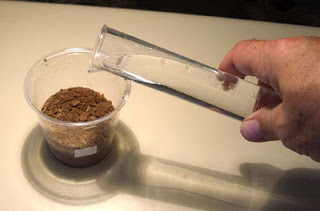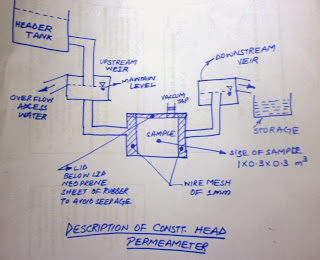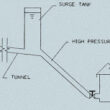So by general or lay man terms; permeability may be defined as;
Ability of material to allow water to pass through it
 |
| Soil in Water |
While technically speaking Permeability may be defined as;
“Rate at which water flows through unit cross-sectional area of soil mass under the action of unit hydraulic gradient provided laminar flow conditions prevails”
This test method is used to determine the coefficient of permeability (K) having units of velocity or m/sec
Designation of the test;
This test method has been standardized by American Association for State Highway and Transportation Officials under AASHTO – T – 215.
Significance of the test:
Coefficient of Permeability:
Description of constant head permeameter
 |
| Description of Constant Head Permeameter |
Sample Preparation
Total amount of material to be used is 200 kg.
The material gradation is as under;
|
Sr. NO
|
Sieve Size
|
%age Passing
|
% Retained
|
Weight of Material (kg)
|
|
1
|
50 mm
|
83
|
17
|
34
|
|
2
|
37.5 mm
|
65
|
18
|
36
|
|
3
|
20 mm
|
40
|
25
|
50
|
|
4
|
10 mm
|
22
|
18
|
36
|
|
5
|
5 mm
|
13
|
9
|
18
|
|
6
|
0.6 mm
|
2
|
11
|
22
|
|
7
|
0.075 mm
|
0
|
2
|
4
|
|
Total
|
200 kg
|
Test Procedure:
- Place the constant head permeameter on leveled and firm surface.
- The Head difference between upstream and downstream weirs must be within 20-40 mm.
- Mix aggregate thoroughly and place in 4 layers in the box.
- Compact the material by using modified AASHTO compacting hammer of 10kg, here no. of blows is not specified time is specified that upto 1 min you will apply blows for each layer while using hammer with normal rate.
- Allow the water to flow from upstream to downstream.
- The vacuum Tap is opened to allow water to pass through sample, on alternate basis the tap is opened and closed to avoid entrapped air.
- Leave the sample over night to allow the sample to get saturated.
Method to determine discharge is simple; you can use some container of known volume and the moment water enters in the container stopwatch is turned on and after the container gets filled stop the stop watch, now you have time and volume you can measure the discharge.
Calculation
K = (V x L) / (A h t)
Where
L = length of the specimen which is 1 m.
A is cross sectional area which is 0.3 x 0.3 m2
H is head difference in meters
T is the time for which known volume of V is filled by water.





















